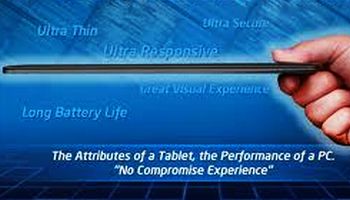Intel Capital, the investment arm of the giant chip maker, will invest $300 million over the next three to four years in companies that build hardware and software technologies for Intel’s ultrabook mobile computing initiative.
The $300 Million Ultrabook Fund forms the latest push in Intel’s aggressive campaign to create a new computing segment of ultra-thin and ultra-light laptops that offer the performance of traditional notebooks and features found in tablets, including long battery life, instant-on and continuously connected capabilities, and eventually, touch technology.
Incentives Attracting Support
Intel executive vice president Sean Maloney unveiled Intel’s concept at the Computex 2011 show in May, and a number of PC OEMs – including Acer, Asus, LG Electronics and Lenovo – have said they plan to create Intel-based ultrabooks this year. By the end of 2012, Intel expects ultrabooks will account for 40 percent of all notebooks sold, according to Maloney.
Intel Capital’s fund will go towards companies that are creating hardware and software solutions that support the ultrabook concept – such as sensors and touch, all-day use through longer battery life, physical designs and improved storage capacity, according to Intel. The Ultrabook Fund is designed to fuel continuous innovation around the concept.
“Ultrabooks are poised to be an important area for innovation in the $X billion global computer industry,” Arvind Sodhani, president of Intel Capital and Intel executive vice president, said in a statement. “The Intel Capital Ultrabook fund will focus on investing in companies building technologies that will help revolutionise the computing experience and morph today’s mobile computers into the next ‘must have’ device.”
While announcing second-quarter financial results in July, Intel executives talked about greater investments in a range of areas, including ultrabooks.
Ultrabooks come at a time when PC sales are slowing. Research firm Gartner said in June that worldwide PC sales would be slower in 2011 than initially predicted, particularly on the consumer side, where buyers are keeping a tighter hold on their money during unpredictable economic times and where there is no compelling reason to buy a new PC. However, the corporate refresh cycle is continuing to churn as businesses embrace the Windows 7 operating system.
Gartner analysts in July said that in the second quarter, PC sales worldwide grew 2.3 percent, slower than in previous quarters. Gartner initially had predicted growth of 6.7 percent.
Intel and some OEMs are hoping that the ultrabook can reinvigorate the PC space. Mooly Eden, vice president and general manager of Intel’s PC Client Group, compared the environments to 2003, when Intel unveiled its Centrino mobile computing chips.
“Celebrating 30 years of innovation, the PC is the ultimate Darwinian device and Intel is striving to again reinvent mobile computing,” Eden said in a statement. “In 2003, the combination of Intel’s Centrino technology with built-in WiFi, paired with Intel Capital’s $300 million in venture investments and other industry enabling efforts, ushered in the shift from desktop PCs to anytime, anywhere mobile computing. Our announcement today is about Intel mobilising significant investments to achieve the next historic shift in computing.”
Lean, Mean Computing Machines
Intel’s ultrabook concept calls for devices that are less than 0.8 inches thick and are priced less than $1,000. Asus already is planning to release its UX21ultrabook this fall, and Acer is rumoured to readying its Aspire 3951 for release, reportedly in October. Hewlett-Packard also is rumoured to be interested in releasing an ultrabook.
 However, some OEMs are content to sit on the sidelines for now, waiting to see how the UX21 does before committing to the concept. A key concern reportedly is pricing, with some doubt that ultrabooks can come in below the $1,000 threshold.
However, some OEMs are content to sit on the sidelines for now, waiting to see how the UX21 does before committing to the concept. A key concern reportedly is pricing, with some doubt that ultrabooks can come in below the $1,000 threshold.
Pricing will be important in determining the success of the form-factor, Beau Skonieczny, an analyst with Technology Business Research, said in a July research note.
“Intel anticipates Ultrabooks will achieve about a 40 [percent] mix in the consumer market by the end of 2012,” Skonieczny wrote. “However, the success will be dependent on a quick ramp of volume sales to translate to lower prices for consumers.”
Intel has created reference designs to help system makers build ultrabooks that can be priced at less than $1,000, and also reportedly is offering financial incentives to OEMs.
Intel officials are taking a multi-phased approach to ultrabooks. The first is underway with the rollout of its 2nd Generation Core chips, built on the “Sandy Bridge” architecture. The chips enable such thin and light ultrabook designs. The next phase comes in 2012, with the release of “Ivy Bridge”, the 22-nanometer follow-on to Sandy Bridge. Ivy Bridge, which will feature Intel’s new Tri-Gate transistor technology, will continue the trend of ramping up performance while improving power efficiency. The chips also will come with greater graphics, responsiveness and security features.
In 2013 comes the “Haswell” platform, which Intel officials say will cut power consumption to half of the thermal design point of current chips.





